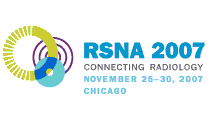
Abstract Archives of the RSNA, 2007
SSC20-08
The Effect of Repetitive MRI Examinations on Patients with Cardiac Pacemakers: Is There a Cumulative Risk?
Scientific Papers
Presented on November 26, 2007
Presented as part of SSC20: Cardiac (MR)
Claas Philip Naehle MD, Presenter: Nothing to Disclose
Alexandra Schmiedel MD, Abstract Co-Author: Nothing to Disclose
Volkert Zeijlemaker PhD, Abstract Co-Author: Employee, Medtronic, Inc
Katharina Strach MD, Abstract Co-Author: Nothing to Disclose
Hans H. Schild MD, Abstract Co-Author: Research Consultant, Dainippon Sumitomo Pharma Co, Ltd
Torsten Sommer MD, Abstract Co-Author: Research Consultant, Medtronic, Inc, Minneapolis, MN
To evaluate the safety of repetitive MRI exams in patients (pts) with cardiac pacemaker (PM).
Inclusion criteria were the presence of a PM and the urgent clinical need for an MRI exam. The study group consisted of 17 pts who underwent a total of 62 MRI exams at 1.5T. To minimize radiofrequency-related lead heating, the specific absorption rate was limited to 1.5W/kg. All pacemakers were reprogrammed pre-MRI: If heart rate 60 bpm, sense-only mode to avoid MR-induced competitive pacing and potential proarrhythmia. Pts were monitored using ECG and pulse oximetry. All PM were interrogated immediately prior to and after the MRI exam, and again after 3 months, including measurement of pacing capture threshold (PCT), lead impedance and battery voltage. All measurements on the first and last MRI were statistically analyzed the using Wilcoxon signed-ranks-test.
9 pts underwent 2 MRI exams, 4 pts underwent 3 MRI exams, 2 pts underwent 4 MRI exams, 1 patient underwent 10, and 1 patient underwent 14 MRI exams. All MR exams were completed safely. Interrogation did not reveal any damage of PM components. Mean time between first MRI exam and last MRI exam was 623 days (range 4-2118 days). Maximum increase of PCT was 1V at a pulse width of 0.4ms (mean 0.13 ± 0.39V). Maximum increase of lead impedance was 216 Ω (mean 18.48 ± 60.14Ω). There was no statistically significant change in PCT (0.92 ± 0.48V vs. 0.92 ± 0.42V; p>0.05) and lead impedance (589 ± 135Ω vs. 590 ± 142 Ω; p>0.05). There was a small, but statistically significant decrease in battery voltage (2.78 ± 0.02V vs. 2.77 ± 0.02V; p<0.05).
There is no evidence that repetitive MRI exams of PM patients are associated with a cumulative risk of damage of PM components, disturbances of PM function or alterations of PCT and lead impedance.
Repetitive MRI exams of PM patients can be performed with an acceptable risk-benefit-ratio under controlled conditions, and by taking both MR and PM related precautions.
Naehle, C,
Schmiedel, A,
Zeijlemaker, V,
Strach, K,
Schild, H,
Sommer, T,
The Effect of Repetitive MRI Examinations on Patients with Cardiac Pacemakers: Is There a Cumulative Risk?. Radiological Society of North America 2007 Scientific Assembly and Annual Meeting, November 25 - November 30, 2007 ,Chicago IL.
http://archive.rsna.org/2007/5015580.html

